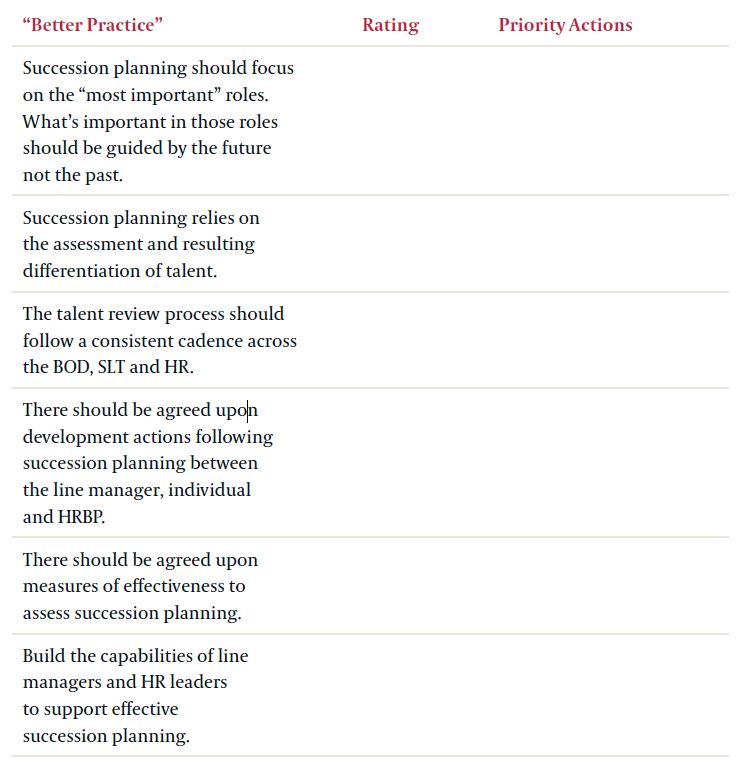The COVID-19 pandemic changed our lives and organizations in countless ways, and for leaders who are accustomed to having control, the feeling of helplessness was unsettling. One of the major talent strategy gaps the pandemic uncovered is succession planning, particularly at the senior levels. Organizations were faced with the question of “what happens if a leader becomes sick?” in real time and some were not prepared for that reality.
This led a number of our clients to question the effectiveness of their own succession planning processes. They face several perennial challenges, including lack of participation from line leaders and lack of clarity in roles and responsibilities. The most pressing challenge we heard was a lack of confidence from the Board in the succession plans for their most senior leaders.
To help leaders think about these challenges in a more constructive way, we spoke with more than 10 CHROs and Heads of Talent about their succession planning practices. We selected organizations across industries, including those well-known for their talent practices and those who are in the process of upgrading them. We discovered that the popular concept of “best practices” is misleading and too static, as those with even the most mature capabilities are also evolving and changing their approach. From these conversations, we developed six “better practices” to help guide our clients’ understanding and assessment of their own systems.
Six Better Practices
1. Succession planning should focus on the “most important” roles (often the top 200, but not always). What’s important in those roles should be guided by future vs. historic capability requirements (based on the business strategy).
What this means:
• Conduct “organizational strategy reviews”
• Define “critical” roles and/or job families based on the org. strategy review
• Determine where a robust bench is required and why and where it makes sense to emphasize external talent
Example:
Most of the organizations we spoke to still consider their most senior roles (e.g., top 200) to be the most critical, though the trend is shifting to define critical roles based on potential value creation. Some overlay their critical roles against a spectrum of what’s important to grow from within versus
what to acquire externally.
2. Succession planning relies on the assessment and resulting differentiation of talent.
What this means:
• Define performance, capability and potential consistently
• Collect objective data for talent reviews (e.g., total CV, 360s, competency assessment)
• Categorize people into “talent pools” (reduce siloes, direct sources for development, increase visibility and movement)
Example:
Most of the organizations we spoke to differentiate high-potential talent (e.g., potential to become a member of the C-suite, or an EVP) and treat it as an enterprise talent pool that is owned by the CEO and CHRO and managed by the C-Suite. Talent pools can also be based on roles, job
families or capabilities.
3. The talent review process should follow a consistent cadence across the BOD, SLT, and HR.
What this means:
• A master calendar that dictates when certain talent topics are covered
• SLT discusses talent regularly and has visibility to successors + “enterprise talent”
• Make use of HR “game-planning” (staffing) to increase agility of succession planning
• “Rules of engagement” for discussions and governance guidelines for decisions
Example:
All the organizations we spoke with cite structure and cadence as key to success. One company uses a talent discussion guide so that conversations stay focused on the right topics. There is a golden rule that unless you have direct experience working with someone, you can only ask questions about them (vs. share opinions).
4. There should be agreed upon development actions following planning between the line manager, individual and HRBP.
What this means:
• Transparency with the individuals who are on the succession plan (minimally “ready-now” candidates)
• Managers are accountable for development plans and use the talent review cadence for ongoing planning
• Bridge succession planning to TA, Total Rewards and L&D functions as part of the process
Example:
Most of the organizations we spoke with adhere to a policy of transparency – “it’s a plan, not a promise.” At one company, Managers are expected to have “five key conversations” with individuals over the course of the year about their career and development.
5. There should be agreed upon measures of effectiveness to assess succession planning.
What this means:
• Define meaning of a “green slate” (tends to be 2-deep bench for ready-now, ready-later and-ready-future)
• Set a slate utilization target (~70%)
• Base KPIs on the talent strategy (ideally covered as part of Better Practice #1)
Example:
One of the benchmark companies is moving from measuring “strong pipelines” to measuring “healthy pipelines,” which look at pipelines more holistically (diversity, performance, assessment data). Another company looks at diversity in their long-term pipeline to focus their talent
acquisition efforts.
6. Build the capabilities of line managers and HR leaders to support effective succession planning.
What this means:
• Provide role clarity and expectations
• For HRBPs: Develop their capability to link business and talent needs and to calibrate with Managers
• For Managers: Develop their capability to have development discussions and use assessment data
Example:
At one company, the Head of Talent conducts organization strategy reviews with the HRBPs to train them how to have those conversations.
While Managers are accountable for decisions and development, HRBPs are expected to truly get to know the talent directly, facilitate talent reviews as a thought partner, and drive active talent management in their areas.
Assessing Your Organization
You can use using the table below to assess where you believe your organization is today and identify where to start. Consider a green/yellow/red rating system; “green” being an area of strength, “yellow” being an area for continuous improvement and “red” being an area for priority focus. It can be a daunting process, but our suggestion is to start the journey with the areas that feel both realistic and high impact.






